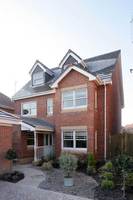Brits still favour the look of bricks and mortar
 Environmentally friendly they may be, but it doesn’t necessarily mean people want to live in eco homes, suggests findings from a survey conducted by Baggeridge Brick and Persimmon Homes.
Environmentally friendly they may be, but it doesn’t necessarily mean people want to live in eco homes, suggests findings from a survey conducted by Baggeridge Brick and Persimmon Homes. Environmentally friendly doesn’t necessarily mean aesthetically pleasing, and the Englishman is notoriously hard to please when it comes to his ‘castle’. Leading brick manufacturer Baggeridge Brick has found that people are put off by new eco homes which can look cold and uninviting.
Results from a recent survey undertaken by Baggeridge in conjunction with Persimmon Homes has in fact revealed that brick is still the favourite facade when it comes to attractiveness and liveability.
When faced with six prototype eco homes, 41.5 per cent of respondents chose Persimmon Homes’ Eco Home – one of the five from the Living-i development – as the most attractive, and similarly, 47 per cent chose the same property as the one they’d most like to live in.
However, the attractive family home duped people into thinking it isn’t eco-friendly, as only two per cent of those surveyed thought it was sustainable. Instead, people plumped for The Lighthouse by architect Sheppard Robson (42 per cent) and the Osborne Demonstration House (26 per cent), both of which feature wooden cladding and unusual design.
Paul Hodgkinson, Baggeridge’s national developer sales manager, comments: “This survey is representative of a lot of opinions. Brick is as popular as ever thanks to the range of looks it can create, but people are unaware of its sustainable properties. In work brick provides high thermal mass properties that help to keep homes cool in the summer and warm in the winter, helping to reduce the need for too much heating and cooling systems which emit C02.”
Regional chairman of Persimmon Homes North West, David Broadbent, adds: “One of our main objectives when building Living-i was to create homes that look like the typical family homes we are famous for, so I’m not surprised that people haven’t identified it as an eco-home. We chose brick because not only is it attractive but offers many environmental benefits too.”
Government targets are now set at making every new home zero carbon by 2016 but often this term is misunderstood. A zero carbon home refers to a property which has neutral carbon emissions from the energy used to heat and light a home – something brick can significantly contribute to.
Paul adds: “The poll has demonstrated that people are still very much interested with the aesthetics of a home, and more often than not, would prefer to live in a traditional brick property. Persimmon’s Eco Home is the ideal solution for those who like the look brick creates, but who want the environmental benefits of its innovative features which help make it low carbon.”
David adds: “With brick, we have shown it is possible to combine the stylish design of a traditional home with the benefits of eco-friendly materials and features to ensure the home is as low-carbon as possible.
“People are comfortable with the look brickwork creates and it helps to bring a human scale to higher density housing schemes now being built in line with Government directives.”
For more information on Persimmon Homes’ Living-i development, visit Living-i.co.uk.

